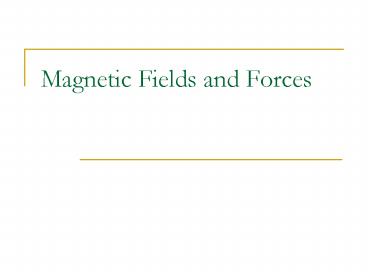Magnetic Fields and Forces - PowerPoint PPT Presentation
1 / 17
Title:
Magnetic Fields and Forces
Description:
Magnetic Fields and Forces Magnetic Force on a moving charge If a MOVING CHARGE moves into a magnetic field it will experience a MAGNETIC FORCE. – PowerPoint PPT presentation
Number of Views:153
Avg rating:3.0/5.0
Title: Magnetic Fields and Forces
1
Magnetic Fields and Forces
2
Magnetic Force on a moving charge
- If a MOVING CHARGE moves into a magnetic field it
will experience a MAGNETIC FORCE. This deflection
is 3D in nature.
B
S
N
S
N
vo
-
- The conditions for the force are
- Must have a magnetic field present
- Charge must be moving
- Charge must be positive or negative
- Charge must be moving PERPENDICULAR to the field.
3
Example
A proton moves with a speed of 1.0x105 m/s
through the Earths magnetic field, which has a
value of 55mT at a particular location. When the
proton moves eastward, the magnetic force is a
maximum, and when it moves northward, no magnetic
force acts upon it. What is the magnitude and
direction of the magnetic force acting on the
proton?
8.8x10-19 N
The direction cannot be determined precisely by
the given information. Since no force acts on the
proton when it moves northward (meaning the angle
is equal to ZERO), we can infer that the magnetic
field must either go northward or southward.
4
(No Transcript)
5
Example
A 36-m length wire carries a current of 22A
running from right to left. Calculate the
magnitude and direction of the magnetic force
acting on the wire if it is placed in a magnetic
field with a magnitude of 0.50 x10-4 T and
directed up the page.
y
B y I -x F
z
x
0.0396 N
-z, into the page
6
Magnetic Flux The DOT product
- How could we CHANGE the flux over a period of
time? - We could move the magnet away or towards (or the
wire) - We could increase or decrease the area
- We could ROTATE the wire along an axis that is
PERPENDICULAR to the field thus changing the
angle between the area and magnetic field vectors.
7
Faradays Law
- Faraday learned that if you change any part of
the flux over time you could induce a current in
a conductor and thus create a source of EMF
(voltage, potential difference). Since we are
dealing with time here were a talking about the
RATE of CHANGE of FLUX, which is called Faradays
Law.
8
Useful Applications
- The Forever Flashlight uses the Faraday Principle
of Electromagnetic Energy to eliminate the need
for batteries. The Faraday Principle states that
if an electric conductor, like copper wire, is
moved through a magnetic field, electric current
will be generated and flow into the conductor.
9
A Dynamic Microphone
10
Microphones
- A microphone works when sound waves enter the
filter of a microphone. Inside the filter, a
diaphragm is vibrated by the sound waves which in
turn moves a coil of wire wrapped around a
magnet. The movement of the wire in the magnetic
field induces a current in the wire. Thus sound
waves can be turned into electronic signals and
then amplified through a speaker.
11
Useful Applications
- AC Generators use Faradays law to produce
rotation and thus convert electrical and magnetic
energy into rotational kinetic energy. This idea
can be used to run all kinds of motors. Since the
current in the coil is AC, it is turning on and
off thus creating a CHANGING magnetic field of
its own. Its own magnetic field interferes with
the shown magnetic field to produce rotation.
12
Generator
A coil of wire turns in a magnetic field. The
flux in the coil is constantly changing,
generating an emf in the coil.
13
An Electric Generator
14
A Simple Electric Motor
15
Magnetic Tape Recording
16
Induction Loop for the Hearing Impaired
17
Transformers
A transformer is a device used to change the
voltage in a circuit. AC currents must be used.
120 V in your house
75,000 V in the power lines
p primary s secondary

